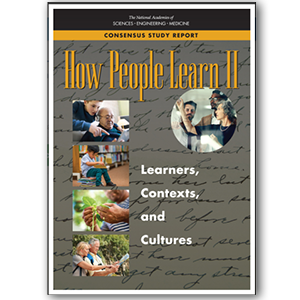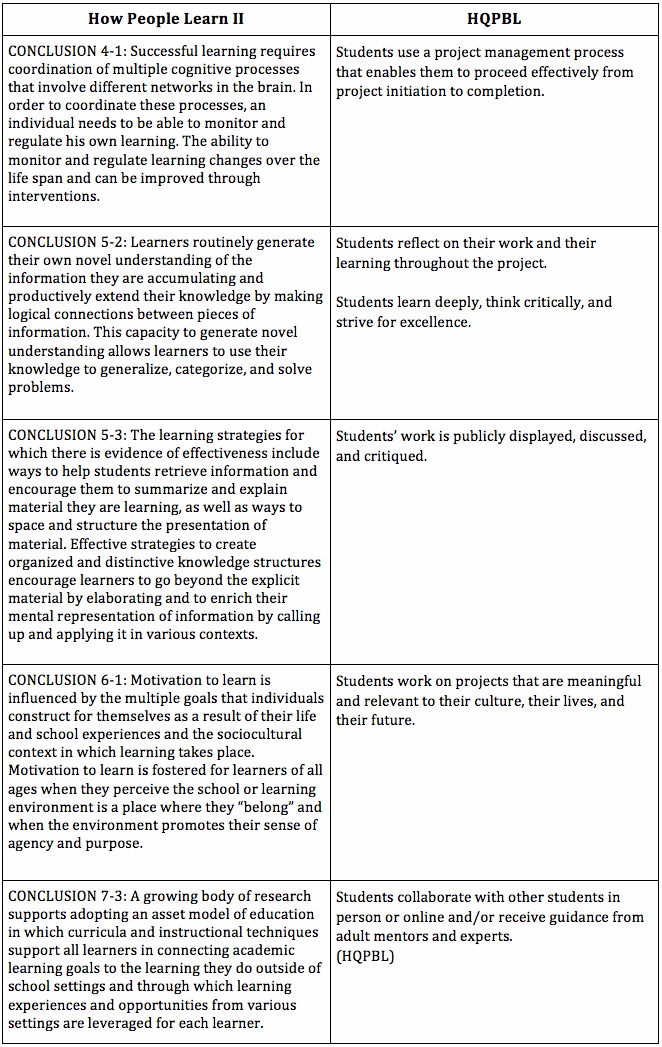In the 18 years since John Thomas produced his ground-breaking white paper, A Review of Research on Project-Based Learning, countless academics and practitioners have focused on demonstrating the efficacy of PBL.

At nearly the same time, the National Academies of Science, Engineering and Medicine produced another white paper, How People Learn: Brain, Mind, Experience and School (2000), which took the conversation to a more fundamental level.
It follows that PBL can only be successful if people actually learn that way.
Science has discovered much about the brain in the intervening 18 years, which is why the National Academies released just a few weeks ago a greatly expanded update: How People Learn II: Learners, Contexts and Cultures.
Many of the conclusions from How People Learn II bear significantly on the arguments in favor of Project Based Learning. In preparation for this blog, I reviewed the study and distilled the 21 conclusions from it into a table that makes for easy reading. You can examine the conclusions in this Google doc as well as find a link to a free download of the full white paper in PDF form.
The next step in this review led to an examination of the tenets of High Quality Project Based Learning, which was the product of a global coalition of educational leaders seeking to define and promote PBL. The table you see below maps the conclusions from How People Learn II to the tenets contained with the HQPBL Framework.

All PBL practitioners should take heart from the conclusions in How People Learn II. Even more importantly, the National Academies report provides support for the Buck Institute’s proprietary model of PBL as defined in the publication Setting the Standard for Project Based Learning.
The Importance of Classroom Culture
One major theme that runs through How People Learn II has given me pause, mainly because I think this fundamental aspect of learning has been under-appreciated by practitioners of PBL as well as traditional teaching. That’s why I was pleased to see the topic of classroom culture addressed so prominently by Suzie Boss and John Larmer in their book, Project-Based Teaching: How to Create Rigorous and Engaging Learning Experiences.
I began to understand the overwhelming impact on culture on the successful implementation of PBL during a decade of international work. Repeatedly during long-term engagements in Korea, China, Costa Rica, the Philippines, and now Russia I and my colleagues have struggled because we are trying to install a new pedagogy amid a classroom culture that resists change.
Three findings from How People Learn II should inform our efforts to implement PBL both in the U.S. and globally:
1. Each learner develops a unique array of knowledge and cognitive resources in the course of life that are molded by the interplay of that learner’s cultural, social, cognitive, and biological contexts. Understanding the developmental, cultural, contextual, and historical diversity of learners is central to understanding how people learn.
2. Motivation to learn is influenced by the multiple goals that individuals construct for themselves as a result of their life and school experiences and the sociocultural context in which learning takes place. Motivation to learn is fostered for learners of all ages when they perceive the school or learning environment is a place where they “belong” and when the environment promotes their sense of agency and purpose.
3. Effective instruction depends on understanding of the complex interplay among learners’ prior knowledge, experiences, motivations, interests, and language and cognitive skills; educators’ own experiences and cultural influences; and the cultural, social, cognitive, and emotional characteristics of the learning environment.
As we think about how best to implement Gold Standard PBL or HQPBL we must ground our work in the primacy of culture. As we now know, cultural deeply impacts how people learn.
David Ross is a Global Education Consultant at Ross Consulting Group. Follow him on Twitter @davidPBLross
Want to learn more about PBL? Check out our books.

